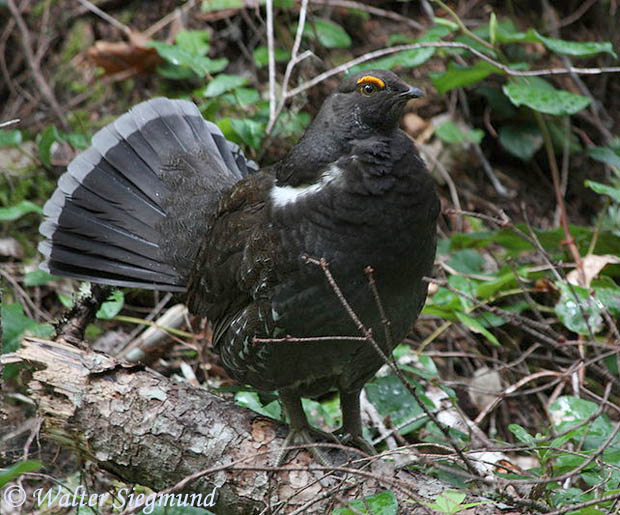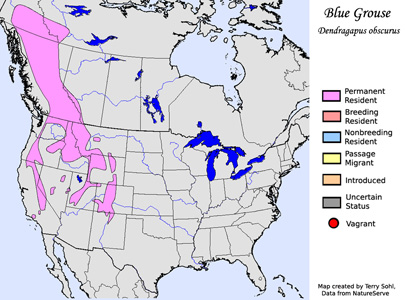| Length: 18 - 20 inches | Wingspan: 24 - 28 inches | Seasonality: Likely extirpated from South Dakota |
| ID Keys: Gray-tip on dark tail, gray overall, orange comb above eyes (male), reddish neck sack surrounded by white feathers (male). | ||
 Until
recently, the Sooty Grouse and the Dusky Grouse
were considered one species, the "Blue Grouse". Range differences,
differences in plumage, and differences in voice help to differentiate the two
species. The Sooty Grouse is found in forested areas near the Pacific
Coast, from northern California all the way to southeastern Alaska, while the
Dusky Grouse is found on more interior forested areas of western North America.
Until
recently, the Sooty Grouse and the Dusky Grouse
were considered one species, the "Blue Grouse". Range differences,
differences in plumage, and differences in voice help to differentiate the two
species. The Sooty Grouse is found in forested areas near the Pacific
Coast, from northern California all the way to southeastern Alaska, while the
Dusky Grouse is found on more interior forested areas of western North America.
Habitat: Found in forested habitats relatively near the Pacific Coast. They can often be found in areas such as forest edges and clearings and second-growth frost.
Diet: The diet is varied, dependent upon location and season, but may include conifer needles, leaves of herbaceous plants such as herbs and ferns, flowers, and other plant material. They will also feed on fruits, berries, seeds and nuts. Young Sooty Grouse feed on insects and spiders during the first several weeks of their life.
Behavior: Primarily forages by walking along the ground and clipping vegetation with their bill.
Nesting: The nest of a Sooty Grouse is a depression on the ground, lined with conifer needles, twigs, strips of bark, leaves, and feathers. The female lays between 3 and 12 eggs, and she alone incubates them. The young can move and feed themselves after hatching, leaving the nest but being taken care of by the female for several weeks.
Song: Loud, deep, 6-note hooting call is given by courting males in the spring.
Migration: Considered a permanent resident throughout its normal range. Some elevational movements may be made in some parts of its range, with birds moving to lower elevations for the winter.
Interactive eBird Map: Click here to access an interactive map of Sooty Grouse sightings
Similar Species: Most similar to the Dusky Grouse, but may also be confused with Spruce Grouse, Ruffed Grouse
Conservation Status: Populations may be in decline, but they are still found over a wide geographic area and are relatively common in some parts of their range. The IUCN lists the Sooty Grouse as a species of "Least Concern".
Further Information: 1) Birdlife International -Sooty Grouse
3) Alaska Department of Fish and Game - Sooty Grouse
Photo Information: Photo taken by Walter Siegmund - Photo licensed under Creative Commons Attribution ShareAlike 2.0 Generic License.
| Click on the map below for a higher-resolution view |
 |
| South Dakota Status: . Note the range map above shows the range for all "Blue Grouse", including both "Dusky" and "Sooty". The Dusky Grouse was once evidently found in the Black Hills of South Dakota, but is now extirpated. The Sooty Grouse is a species of further west in North America. |
Additional Sooty Grouse Photos (Coming soon)
